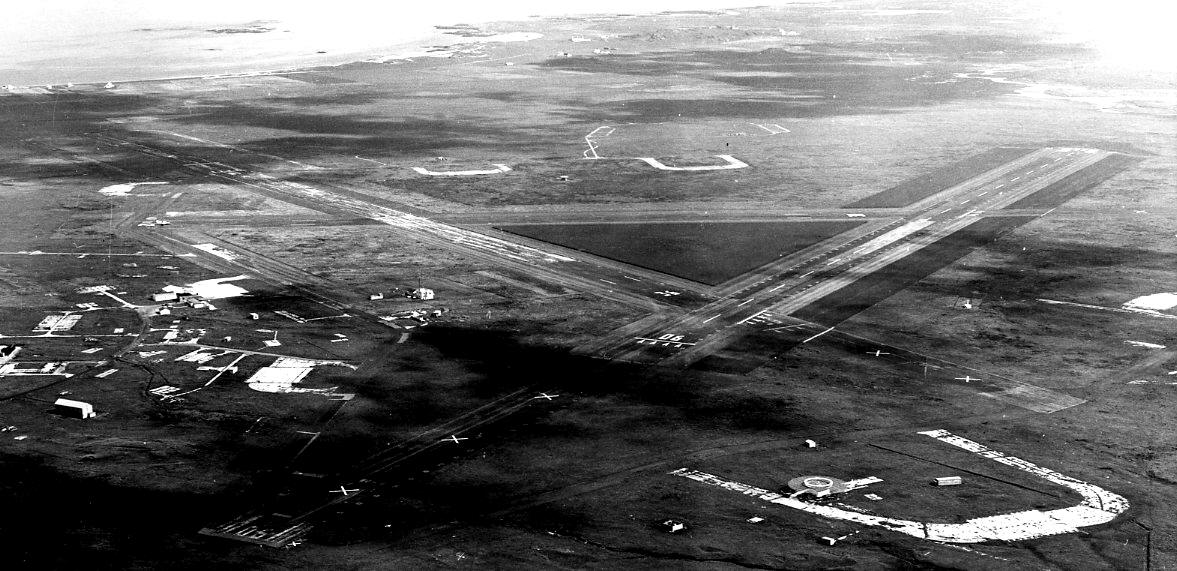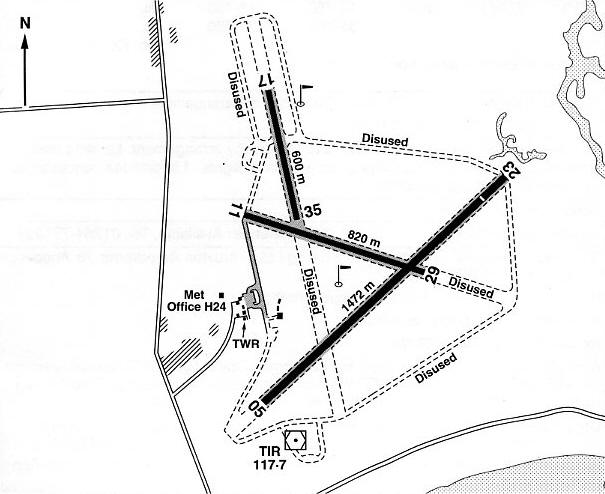Tiree
TIREE: Military airfield in WW2, later regional airport (Aka REEF)
Note: First picture from the The John Stroud Collection. Second picture from Google Earth ©
Military user: RAF Coastal Command 15 Group
281 (ASR) Sqdn (Vickers Warwicks & Supermarine Sea Otters)
518 Sqdn (Handley Page Halifaxs)
Operated by:
1965: Miinistry of Aviation
1975: Department of Trade & Industry
1980s to 2000: Highlands & Islands Airports Ltd
Airline users: Pre 1940: Scheduled services by Northern and Scottish Airways, subsequently Scottish Airways in the 1930s
Post 1945: BEA, Hebridean Air Services, Loganair
TWO PICTURES
These two pictures from postcards were kindly sent by Mike Charlton who has an amazing collection: See: www.aviationpostcard.co.uk
First picture: This de Havilland DH89A Dragon Rapide (G-AGUV) first served with the RAF as NR844 when it was called a Dominie. It was first on the civil register, 30th October 1945, registered to Great Western & Southern Airlines based at SPEKE airport Liverpool, and operated until the 31st January 1947. It was then acquired by BEA (British European Airways Corporation) on the 1st February 1947 and operated until the 6th January 1953 - during which times this picture was taken.
It then went to Gibraltar for just on a year, operated by Gibraltar Airways from the 13th January 1953 until the 29th December 1953. Then it returned to the UK registered to Mr A J Whittmore and based at CROYDON from the 18th February 1954 until just over a month later - 22nd March 1954. I expect there is a story to be told here as it appears G-AGUV was destroyed by fire in Bahrein on the 26th April 1954. The exploitation of the oil fields in the Middle East was just getting under way, so presumably G-AGUV was involved in this?
Location: N of B8065, SSE to SE of Kenovay, roughly 2nm W of Scarinish, on the Isle of Tiree
Period of operation: Probably from 1933, certainly 1937 to present day
Note: These maps are reproduced with the kind permission of Pooleys Flight Equipment Ltd. Copyright Robert Pooley 2014.
Runways: Originally ‘all over’ grass airfield (?)
WW2: 06/24 1682x46 hard 12/30 1280x46 hard
18/36 1829x46 hard
1965: 06/24 1158x46 hard 12/30 792x46 hard
18/36 954x46 hard
1990: 06/24 1000x23 hard 12/30 730x18 hard
18/36 954x46 hard
2000: 05/23 1472x30 hard 11/29 820x19 hard
17/35 600x18 hard
Helipad: Near the control tower in the SW of the airport
SOME MORE ITEMS
These have been very kindly provided by Mr Mike Holder, another great friend of this 'Guide'.
NOTES: Some history
Although I cannot confirm that the airport on Tiree known as REEF in the 1930s is exactly on the same site as the present airport, it seems doubtful it was situated elsewhere on the island? The Isles of Tiree and Coll are also known as the Inner Hebrides.
The air ambulance service offered by Scottish Airways from REEF in the 1930s cut the journey time from a bare minimum of fifteen hours if the daily ferry could be caught, to around one hour. Call it three hours if a dedicated return flight was required from chock to chock. If the costs of the flight, at £10 per flying hour in those days, (possibly equating to £1000 per hour or much more today?), exceeded the patients ability to pay the costs were divided between the Highlands and Islands Medical Service of the Health Department and the County Council. From January 1935 to January 1939 it was claimed the Air Ambulance Service carried some 300 cases of which the vast majority survived.
In his most valuable book Air Ambulance Iain Hutchison quotes an article written by George Blake in the Scottish Daily Express which Scottish Airways featured in their 1939 brochure, giving an example of a typical Air Ambulance flight routine. I think this excerpt is well worth quoting, bearing in mind that the original air ambulance services to the nearer of the Western Isles started in 1933: “Six years ago, the doctor will reflect, that life would almost certainly have been lost. A diseased appendix, a shooting accident, or a bicycle smash would have meant, at the best, a make-shift operation by a general practitioner in a rarely used cottage hospital. In remoter parts it would probably have meant just doing the best to ease the agonies until the inevitable end came.”
SOMETHING TO COME
This makes for salutary reading, I trust you’ll agree. And, George Blake makes another point in his article; “The air ambulance has never had a flying mishap.” Needless to say, after WW2 when BEA got involved, a fatal flying accident soon occurred. BEA had an appalling record of fatal accidents for a national airline, as did BOAC for that matter. Hence I suppose the need to reconstruct and develop an entirely new concept of how to operate a nationalised airline called British Airways with hopefully a far better safety record?
I will make no apology for expressing this opinion. Some damned fool in BEA decided the DH.114 Heron should be used to serve the most inhospitable destinations, rather than for example, the Scottish Aviation Twin Pioneer which was available in those days. I expect the Heron was much cheaper to operate?
WW2 and 518 SQUADRON
518 Squadron were equipped with the Handley Page Halifax and their principal duties involved flying way out into the Atlantic to produce weather reports and also looking out for U-Boats. As far as I can make out these aircraft were unarmed to save weight and increase endurance. This often involved flying in atrocious weather for sorties of ten hours or more. As the weather systems which develop across the North Atlantic dominate the weather in the UK and western Europe these reports were of great value in helping the Met people back in the UK produce more accurate forecasts. Perhaps never more so than when the D-Day landings were in the final planning stages. A storm during the night and in the morning would have proved disastrous.
Needless to say this was highly dangerous work and 518 Squadron lost twelve crews in a period of eighteen months. Invariably the aircraft and crews disappeared without trace. The squadron was based here from the 25th September 1943 until the end of WW2 when it was transferred to ALDERGROVE (NORTHERN IRELAND). From September 1943 to June 1945 they flew the Halifax Mk.V and from March 1945 to October 1946 the Halifax Mk.III.
MORE ON THE AIR AMBULANCE
However, TIREE has another claim to fame and once again I shall quote from Iain Hutchison’s excellent book Air Ambulance. “The first birth to take place in the air occurred on 28th February”…. (1950) … “..when Lachlan Macfarlane was born above the Gulf of Corrievrechan while his mother was being flown from Tiree to Renfrew. The Rapide, under the command of First Officer Stanley Brown, had been diverted from the Hebrides scheduled service.”
For me, being a pedantic old sod, this account raises a question. The Rapide could only be flown by one pilot. And, as far as I understand Air Law, the pilot ‘in command’ must be a Captain? In the Rapide a training Captain can more or less stand around, looking over the shoulders of the pilot being trained or examined, but still being the ‘Pilot in Command’? Perhaps things were different in those days? This is the first time I have come across a First Officer apparently being in sole command of an airliner.
After D-Day and as the Allied forces advanced across western Europe it became clear that the, (by then), Coastal Command Air-Sea Rescue squadrons had to be reorganised and reformed. The result being 279 Sqdn based at THORNABY (YORKSHIRE), 280 Sqdn at BECCLES (SUFFOLK), 281 Sqdn at TIREE (ARGYLLSHIRE) and 282 at St EVAL (CORNWALL). Needless to say, all four squadrons maintained detachments at other airfields.
We'd love to hear from you, so please scroll down to leave a comment!
Leave a comment ...
Copyright (c) UK Airfield Guide


























